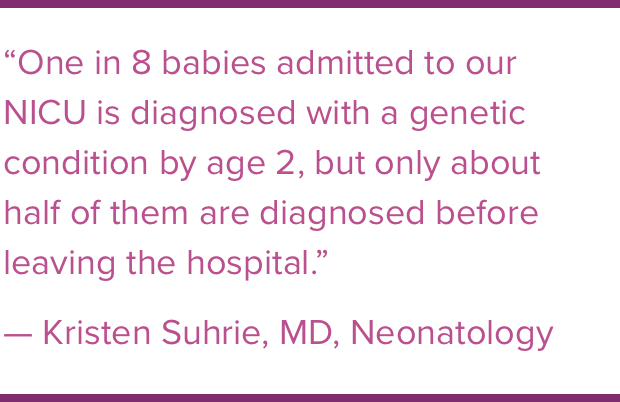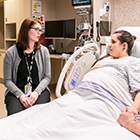Head-To-Head Comparison of Genetic Testing Platforms Could Lead to Better, More Cost-Effective Care

Every year, 30% of patients in the Cincinnati Children’s newborn intensive care unit (NICU) are evaluated for a possible genetic diagnosis. But test results aren’t always available prior to discharge, which can mean a missed opportunity for early interventions. That’s why neonatologist Kristen Suhrie, MD, is excited about her team’s participation in the Genomic Medicine for Ill Neonates and Infants (GEMINI) study, which is sponsored by the National Institutes of Health.
The clinical study will compare the clinical and economic utility of performing a targeted genomic sequencing panel verses rapid whole genome sequencing (rWGS) for neonates suspected of having a genetic disorder. Cincinnati Children’s is the top enrolling site for this five-year multicenter study, which includes five other pediatric institutions.

“One in 8 babies admitted to our NICU is diagnosed with a genetic condition by age 2, but only about half of them are diagnosed before leaving the hospital,” says Suhrie. “When babies go home without a definitive diagnosis, it can mean months or even years of uncertainty for their families. An early diagnosis means we can educate families about their child’s condition, provide targeted interventions in the NICU setting and involve subspecialists we might not have otherwise known to consult.”
The study involves a head-to-head comparison of the two testing platforms. The genomic sequencing panel is less expensive and targets more than 1,700 genes known to cause genetic disease in newborns with results available within five days, compared to rWGS, which looks at the entire human genome with results available in two weeks.
“We appreciate the pros and cons of each testing method, but the research study will help us understand if one technology is superior for diagnosing genetic problems in infants,” Suhrie says.
After results are available, the attending caring for the patient will complete a clinical utility survey to evaluate how the testing affected clinical management. Parents will complete monthly health surveys to understand how test results may have impacted healthcare utilization over the first year of life. Data will be used to compare to historical controls to understand if there has been further healthcare and economic benefit to early genetic testing and an early genetic diagnosis.
“A NICU stay is expensive, but so is the ongoing cost of caring for kids with a genetic disorder,” Suhrie says. “We want to know if an early diagnosis can ultimately impact outcomes and lower healthcare costs compared to historical controls.”
The Molecular Diagnostic Lab at Cincinnati Children’s provides state-of-the-art genetic testing (including exome sequencing) for a variety of genetic disorders and risk factors, as well as comprehensive interpretation of test results by nationally recognized, board-certified pediatric specialists, geneticists and genetic counselors. Learn more about the Molecular Genetics Lab.

